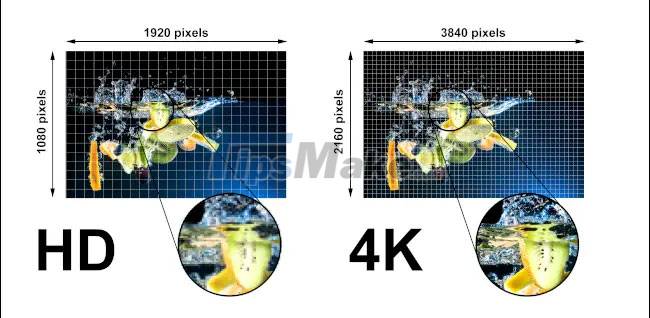What is Dynamic Resolution Scaling? Dynamic Resolution Scaling What does it mean in graphics processing?
Why are more and more games using this technique to give players a more optimal experience?
What is DRS?
Dynamic resolution scaling is a technique used in both PC and console games that alters the top resolution to improve performance. When the graphics processing unit (GPU) encounters a 'hard to chew' task, DRS can be used to reduce the output resolution, thereby keeping the overall performance steady.
This can be understood as a way to reduce stress on the GPU, helping to maintain a stable frame rate. Games that do not use DRS will be locked to the set resolution, and that may lead to poor performance in some usage scenarios, or force developers to consider other methods other reduction methods.

This is done by the game engine, which can adjust the resolution up and down for optimal smooth performance. The developers will decide the minimum (and maximum) resolution that the game can reach. Through DRS, this resolution can be flexibly adjusted depending on the actual hardware configuration.
This process is not linear and can occur to varying degrees on different axes. Scaling resolution on one axis is often a lot less noticeable than linear scaling resolution affecting horizontal and vertical axes. Many games limit scaling to the horizontal axis, even though it is properly rendered at the correct aspect ratio (the pixels are stretched).
During the motion, many players will not notice that the resolution of the game has been reduced. Additional techniques such as temporary anti-aliasing can be used to smooth out jagged lines that often appear with low resolutions.
Overall, DRS is a useful tool because it helps reduce render times on the GPU. When a scene takes too long to render, the frame rate will drop because the GPU can't process them in the time it takes to achieve the desired frame rate.
For example, 60fps frame rate requires the GPU to process and render a new frame every 16.667 milliseconds. If rendering a certain frame takes longer than this, the frame is skipped and the overall frame rate is reduced. Variable refresh rate (VRR) technology makes this less noticeable by eliminating screen tearing, while DRS can help boost performance across the entire session.
Take a simpler example. The number of pixels in a 4K image is four times as many as in a 1080p (full HD) image, so the GPU would have to render four times as long to process an image in 4K as it does in 1080p . Lowering the resolution will reduce render time, giving the GPU the space it needs to reach the desired frame rate.

So, if a 4K image is rendering at 30fps, and you want to hit the 60fps goal, then halving the resolution will allow the GPU to achieve this goal under ideal conditions and no settings. else is changed.
DRS keeps the overall setup steady
Resolution is only one part of the frame rendering time equation. Detail (LOD), shadow quality, shader quality, etc. can all affect render times and performance. Developers can use various techniques to reduce image quality in order to achieve higher frame rates.
One of the biggest benefits of DRS is that it allows developers to ignore many other settings just to reduce output resolution. This allows the graphics quality of the game to be kept consistent across different platforms or hardware, with the exception of resolutions.
In actual use, users also do not need to care too much about DRS, other than occasionally turning it on and off in PC games. Console games rely heavily on technology, which can vary greatly in implementation and is often changed in updates based on data collected by developers and player feedback.
You should read it
- Is 4:3 or 16:9 aspect ratio better for photos and videos?
- How to Change Mac Screen Resolution
- Adobe Premiere Pro has the ability to automatically change the video aspect ratio
- How to set an individual DPI ratio in a multi-monitor setup
- HMD officially launched Nokia 1.3 cheap
- Laptop: Broader, more 'delicious'
- What do you know about golden ratios (Golden Ratio) in design?
- How to Change the Screen Resolution on a Mac
May be interested
- How to Scale in AutoCAD
 this article will show you how to scale lines, objects, groups, blocks, or images in autocad in two ways. the first is scaling by a factor, the second is scaling with a reference. both methods are useful to autocad users and make life just...
this article will show you how to scale lines, objects, groups, blocks, or images in autocad in two ways. the first is scaling by a factor, the second is scaling with a reference. both methods are useful to autocad users and make life just... - How to Reduce Screen Scaling in Windows 8
 windows 8 is the latest os in the windows series, and on tablets the desktop view is made larger so it can be touched easier. the only issue is that it compromises the look of some desktop applications. open control panel. in windows 8.1,...
windows 8 is the latest os in the windows series, and on tablets the desktop view is made larger so it can be touched easier. the only issue is that it compromises the look of some desktop applications. open control panel. in windows 8.1,... - Basic knowledge of dynamic DNS service system
 dynamic dns is a method of mapping domain names to ip addresses with high frequency changes (since not all computers use static ip addresses). dynamic dns service provides a special program that runs on the user's computer using the dynamic dns service called dynamic dns client.
dynamic dns is a method of mapping domain names to ip addresses with high frequency changes (since not all computers use static ip addresses). dynamic dns service provides a special program that runs on the user's computer using the dynamic dns service called dynamic dns client. - How to use Dynamic Island on iPhone 15
 the dynamic island feature does not need to be enabled or configured for it to do its job; it will start automatically when your phone is unlocked and any supported activities are running.
the dynamic island feature does not need to be enabled or configured for it to do its job; it will start automatically when your phone is unlocked and any supported activities are running. - What is 4K resolution?
 4k is the concept that refers to either high resolution: 3840 x 2160 pixels or 4096 x 2160 pixels. 4k 4 times pixel resolution and double line resolution (2160p), 1080p (1920 x 1080 pixels).
4k is the concept that refers to either high resolution: 3840 x 2160 pixels or 4096 x 2160 pixels. 4k 4 times pixel resolution and double line resolution (2160p), 1080p (1920 x 1080 pixels). - What is Dynamic Island? What effect does Dynamic Island have on iPhone 14 Pro?
 simply put, dynamic island is the name of the notch on the iphone 14 pro screen and is also the name of the new adaptive feature that apple created.
simply put, dynamic island is the name of the notch on the iphone 14 pro screen and is also the name of the new adaptive feature that apple created. - What is 16K resolution?
 there's a lot we don't know about 16k monitors, aside from the fact that they'll have incredible pixel density and benefit super-large tvs.
there's a lot we don't know about 16k monitors, aside from the fact that they'll have incredible pixel density and benefit super-large tvs. - Nvidia released a major driver update with many notable improvements
 nvidia is planning to release a major driver update for its graphics card models this week.
nvidia is planning to release a major driver update for its graphics card models this week. - Tips for using Dynamic Island on Android smartphones
 there are many applications that support bringing dynamic island to android phones, such as the dynamic spot application. after you set up dynamic spot to work on your android phone, we will see the same black bar display interface as on the iphone.
there are many applications that support bringing dynamic island to android phones, such as the dynamic spot application. after you set up dynamic spot to work on your android phone, we will see the same black bar display interface as on the iphone. - iPad, the next iPhone version handles graphics 4 times faster
 the new sgx543mp2 dual-core graphics chip helps increase graphics processing performance on ipads and iphones by four times the current level.
the new sgx543mp2 dual-core graphics chip helps increase graphics processing performance on ipads and iphones by four times the current level.










 What is A-GPS positioning technology? What is the effect of A-GPS? A-GPS On which device?
What is A-GPS positioning technology? What is the effect of A-GPS? A-GPS On which device? What is WiFi MIMO? WiFi MIMO What are the benefits? How Does WiFi MIMO Work?
What is WiFi MIMO? WiFi MIMO What are the benefits? How Does WiFi MIMO Work? Learn about Ransomware: 6 ransomware on computers
Learn about Ransomware: 6 ransomware on computers What is the difference between GUI and CLI?
What is the difference between GUI and CLI? What is WDR technology?
What is WDR technology? What does the hole in the back cover of some Intel CPUs do?
What does the hole in the back cover of some Intel CPUs do?